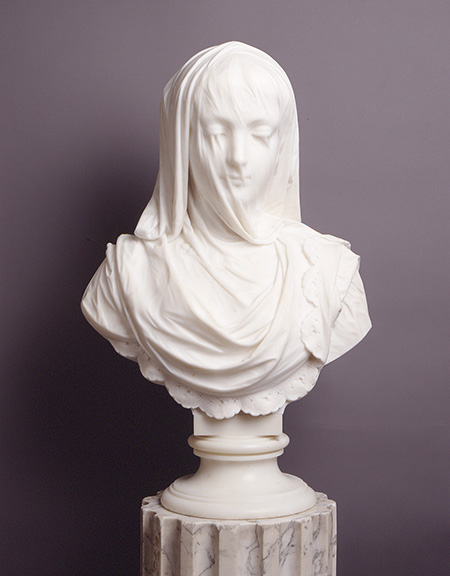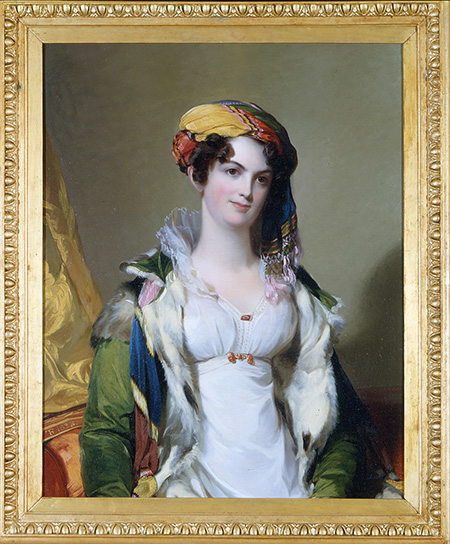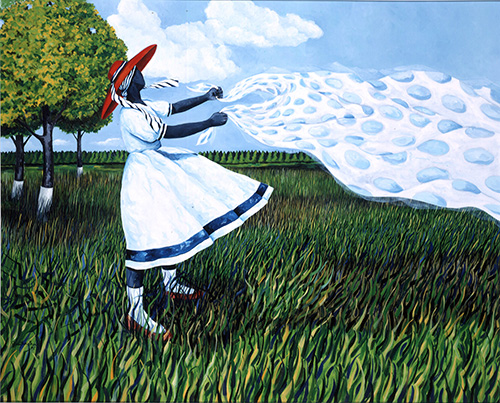Every six months, the curatorial and collections staff at the Gibbes rotates artwork on view in our permanent exhibition—The Charleston Story. Arranged chronologically, this exhibition features the museum’s core collection of American art and allows our visitors to follow the course of fine art in the South from the eighteenth century to the present. The exhibition highlights artists and images of Charleston through a wide range of media and artistic styles—from Benjamin West’s Colonial era oil painting of Thomas Middleton of the Oaks, to Pietro Rossi’s exquisitely carved marble the Veiled Lady, to Leo Twiggs’ batik rendering Sarah Remembered. This biannual refreshing of the permanent exhibition galleries allows us to highlight a broader range of the nearly 7000 works of art in the Gibbes collection.

As is true in most museums, only a small percentage of the Gibbes’ treasures can be on view at one time and it is always exciting to see new artwork on the walls. I am often asked “How do you decide what works are exhibited?” Or when a beloved work is missing from our walls, “Why isn’t ‘such and such’ artwork on view now?” There are several key factors that guide our decision making when changes to the permanent galley spaces take place. In addition to thematic factors, curatorial changes are determined by preservation requirements, educational needs, and logistics.
Preservation requirements prioritize many of the changes that take place. For instance, oil paintings on canvas and marble sculptures are less sensitive to light damage than watercolor paintings on paper. Therefore audience favorites such as Thomas Sully’s 1823 portrait of Mrs. Robert Gilmor, Jr. and Barkley Hendricks’ 1972 portrait of Ms. Johnson (Estelle) can remain on view for a longer duration than Alice Smith’s watercolor landscape Reserve at Fairlawn on the Wando. Light exposure over time can cause fading and deterioration. The Gibbes and other museums take measures to reduce light intensity for works on view in galleries. However, some light is obviously a necessity. Light damage is cumulative so it is the total exposure over time that matters. In order to ensure the longevity of our more sensitive objects it is necessary to rotate works on paper, pastels, and watercolors to limit light exposure over time.

Curatorial selections are not made in isolation. The Gibbes has a robust art education program led by Curator of Education, Rebecca Sailor, and a group of truly dynamic museum educators. The needs of our museum teachers, docents, and our new Junior Docent program are all taken into account. Thousands of students from pre-school through high school are introduced to the museum’s collection every year. Thematic groupings such as portraits that contribute to the telling of South Carolina’s role in the Revolutionary War like Rembrandt Peale’s painting of General William Moultrie or James Earl’s portrait of General Cotesworth Pinckney enhance social studies curriculums and are frequently used by our museum teachers. These paintings are displayed in close proximity to each other and are rarely placed in storage. Contemporary works are also popular with students and museum teachers, so a painting such as Jonathan Green’s Corene that fits chronologically on the third floor balcony gallery occupies a central location. which allows the students room to gather for discussion.

The Charleston Story occupies six different gallery spaces on the first floor of the Gibbes and continues through portions of the second and third floor. Logistical considerations are broad in range—we ask ourselves many questions prior to any artwork installation. Does this work fit in the gallery chronologically and thematically? Does this work fit on the wall based on its size and composition? Does this work have special exhibition requirements such as casework or limited lighting? How will the display of this work affect traffic flow for visitors, school groups, and other programs? Is this work scheduled to go on view at the Gibbes in a different exhibition? Is this work scheduled to go on loan to another institution? What interpretive material is required? Will this work be highlighted on the cell phone tour? Does this work enhance other programs scheduled? In general, how can it best be displayed for our visitors now and in the future?
While each work of art in a museum stands on its own merit, an important part of the museum experience is the opportunity to make comparisons between works, and to understand the context in which the artwork was created. Providing an atmosphere that enhances and enriches our visitor’s interactions with the art is our primary goal. As we move forward with our plans to expand and renovate the Gibbes building, we will be able to showcase more than 600 works of art from the permanent collection in an environment that includes new walls and flooring, high-quality lighting, visitor-friendly display casework, and innovative platforms for interpretation. Not to mention a new café, renovated gift shop, and art-making studios—all the amenities necessary to inspire a creative community!
—Sara Arnold, Curator of Collections, Gibbes Museum of Art
Published February 28, 2014

